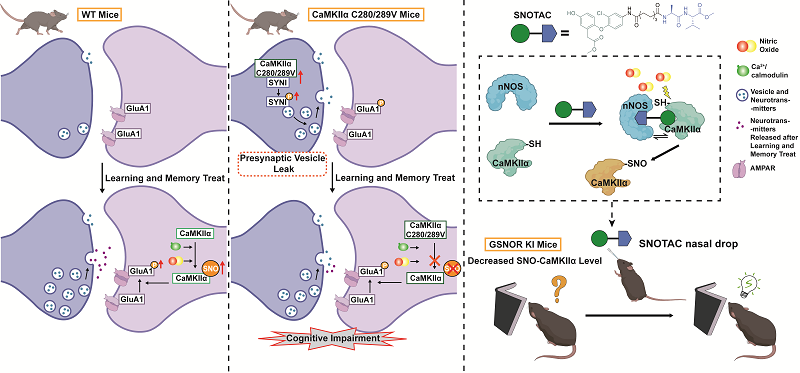
A research team led by Prof. CHEN Chang from the Institute of Biophysics of the Chinese Academy of Sciences, in collaboration with Prof. HUANG Zhangjian of China Pharmaceutical University, has uncovered a previously unknown molecular mechanism essential for learning and memory.
The study, published in Redox Biology on August 6, reveals that S-nitrosation of CaMKIIα—a redox-based post-translational modification—plays a critical role in cognitive processes.
The researchers also developed SNOTAC, a precision S-nitrosation modulator distinct from conventional nitric oxide (NO) donors, offering a promising new therapeutic strategy for memory impairment.
The researchers first examined whether CaMKIIα S-nitrosation levels change during physiological learning and memory processes. In wild-type mice, exposure to learning and memory tasks significantly increased CaMKIIα S-nitrosation in the hippocampus.
To test its functional role, they engineered mutant mice incapable of undergoing this modification. Across multiple behavioral assays, these mutants displayed pronounced deficits in learning and memory. Together, the results provide compelling evidence that CaMKIIα S-nitrosation represents a novel regulatory mechanism in physiological cognition.
Mechanistic studies revealed that loss of CaMKIIα S-nitrosation caused abnormally elevated presynaptic vesicle release in the resting state. When cognitive tasks demanded a neural response, the synapses of these mice exhibited diminished signaling capacity-ultimately impairing memory formation.
Building on Prof. CHEN's "precision redox" concept and the "5R" principles for antioxidant drug development, the researchers designed a targeted intervention strategy. They introduced a versatile "molecular glue" approach: a small molecule that draws the target protein into close proximity with nitric oxide synthase (NOS), enabling its enzymatically produced NO to selectively modify the protein via S-nitrosation. Applying this principle, they innovatively designed and synthesized the S-nitrosation targeting chimera (SNOTAC).
SNOTAC specifically brings neuronal nitric oxide synthase (nNOS) into proximity with CaMKIIα, thereby enhancing its S-nitrosation precisely and selectively. Intranasal delivery of SNOTAC successfully restored memory performance in mice with deficits caused by brain-specific overexpression of GSNOR.
This study is the first to demonstrate that CaMKIIα S-nitrosation is a critical post-translational modification for learning and memory-independent of the well-known phosphorylation pathway. It also identifies a new mechanism in which abnormal presynaptic vesicle release drives cognitive decline, providing fresh insight into age-related memory loss. The development of SNOTAC represents a proof-of-concept for targeted redox modulation as a means to rescue cognitive function, setting a precedent for future precision redox therapies.

CaMKIIα S-nitrosation and its precise regulation play a key role in learning and memory (Image by CHEN Chang's group)

86-10-68597521 (day)
86-10-68597289 (night)

52 Sanlihe Rd., Xicheng District,
Beijing, China (100864)

